Jeon Ju (Los Angeles, CA)
Jeon Ju
2716 W Olympic Blvd, Los Angeles, CA 90006
213.386.5678
www.yelp.com/biz/jeon-ju-restaurant-los-angeles (Yelp, restaurant has no web site)
Sat 09/13/2008, 08:35p-09:45p
After having bibimbap for the first time in Japan, I desperately wanted to recreate the experience here in the States. While early attempts left me wanting, I'd since been convinced that comparable bibimbaps were indeed available stateside, but I still hadn't had it in Koreatown. That's where Jeon Ju comes in. The restaurant came highly recommended by a number of people, including a commenter on this very blog. Let's see how it stacked up.
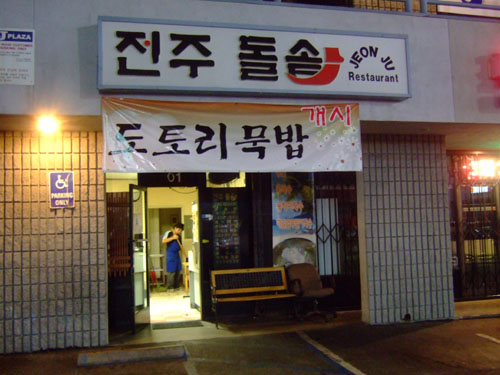
Jeon Ju is located on the first floor of a two-story strip mall. Parking is provided in a small lot, which I hear can become quite packed at peak hours.
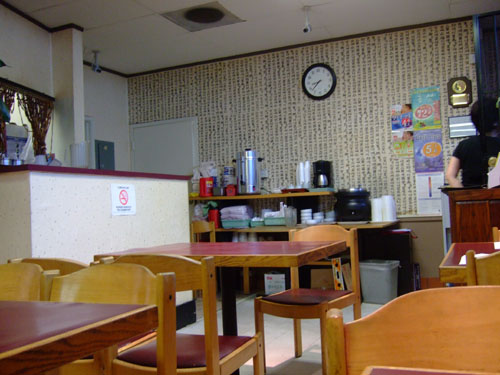
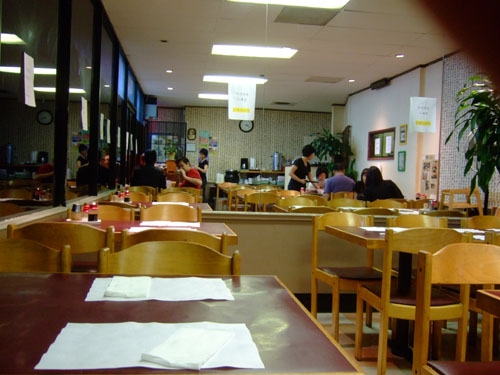
The interior is fairly small (though the mirrors make it seem bigger), with seating for about 50 people. There's not much decor to speak of, though the Korean script gracing the walls is somewhat unique.
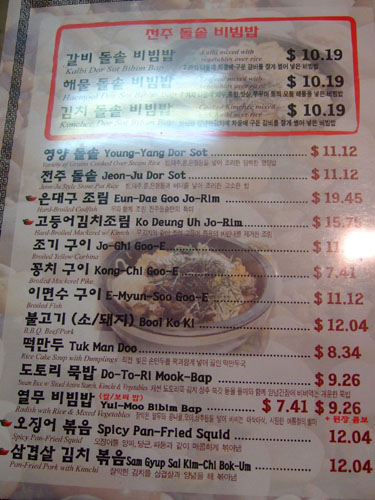
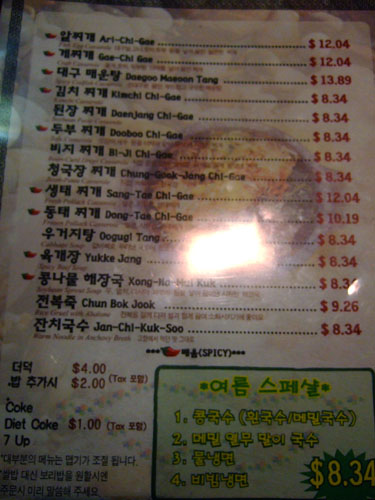
Jeon Ju can do much more than bibimbap, as evidenced by the fairly lengthy menu. Note however that the three preparations of bibimbap are highlighted right up top. Also note the odd pricing, as I encountered at Young Dong Tofu, presumably to simplify tax calculations. Click for larger versions.
We'll begin with a recounting of the various banchan that we were presented with.
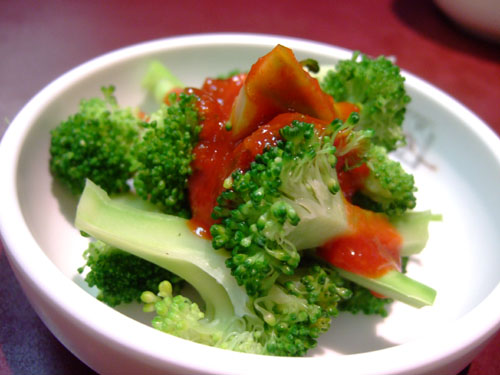
Broccoli with Gochujang
Raw broccoli goes quite well with a cool Ranch dressing. I found out that it also goes well with spicy gochujang, a Korean condiment made with chili powder, glutinous rice powder, fermented soybeans, and salt. Gochujang is also widely used as a flavoring for bibimbap, as we'll see below.
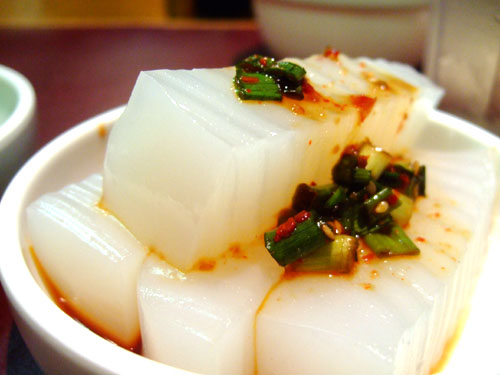
Cheongpomuk Muchim
Cheongpomuk, also known as nokdumuk, is a Korean muk (jelly) made from mung bean starch. The jelly was well garnished with soy sauce and scallion, as the cheongpomuk had little flavor of its own. The consistency was dense, and slightly chewy, reminiscent of Japanese konnyaku jelly.
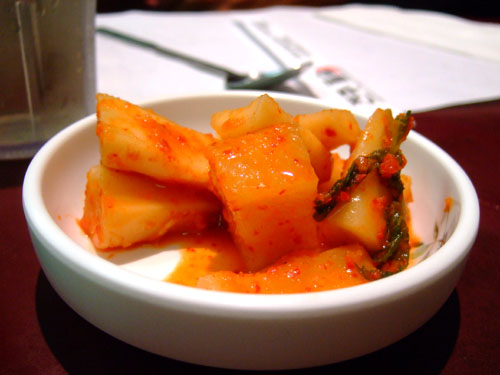
Ggakdugi
Ggakdugi is a type of kimchi made from mu (daikon radish). The radish is cubed and typically flavored with salt, red chili powder, scallions, and ginger. I much enjoyed the ggakdugi's crispness and milder flavor.
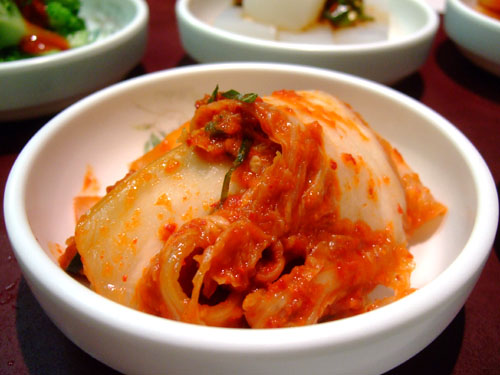
Baechu Kimchi
A meal just wouldn't seem complete without kimchi, specifically baechu kimchi, the most popular variety, made from napa cabbage. This was exactly what I expected from kimchi, and I found it to be spicier and saltier than the ggakdugi and water kimchi below.
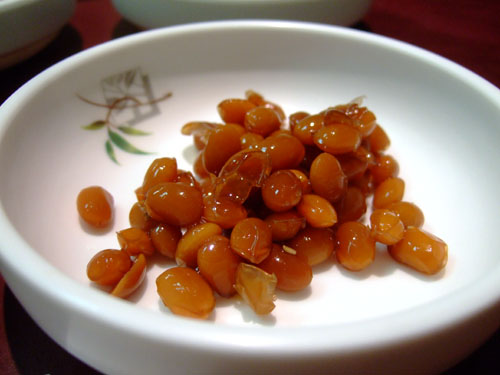
Kong Gan
I was informed by one of my dining companions that this was known as "white bean." I'm thinking these are azuki beans perhaps? Unfortunately, I forgot to sample them.
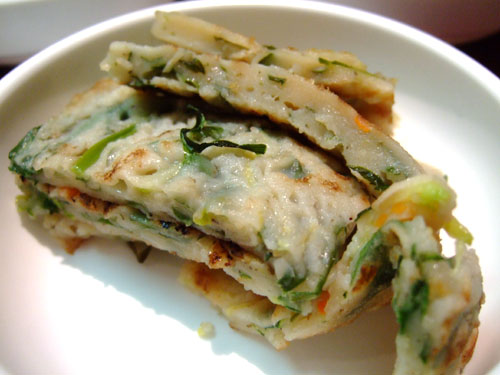
Pajeon
Pajeon is a type of jeon, a pancake-esque dish made of eggs, flour, and green onion. It was soft in texture with a mild flavor, and was one of my favorite banchan.
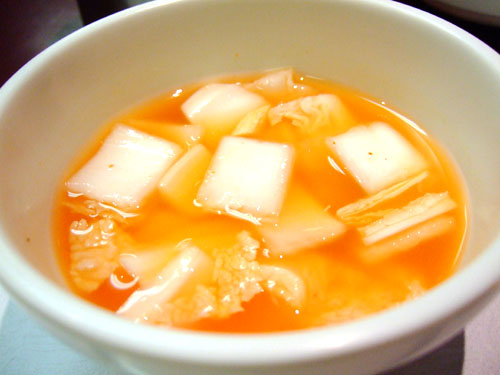
Mul Kimchi
Mul means water, so this was basically kimchi in water. It had a much milder taste than normal kimchi, with less salt, but still packed a delightfully garlicky tangy. Very nice.
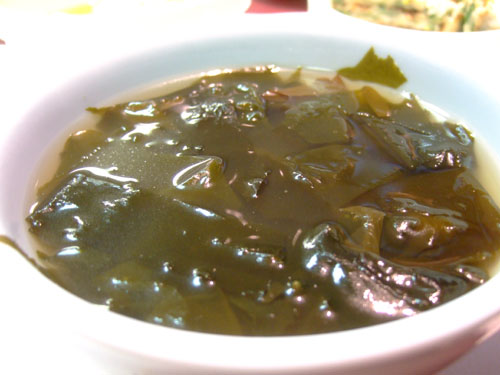
Miyeok Guk
Miyeok guk is a soup made from wakame, a type of edible kelp commonly used in Japanese cookery.
As Jeon Ju is most well known for bibimbap, we decided to try all three varieties offered, all served dolsot style (in a stone pot).
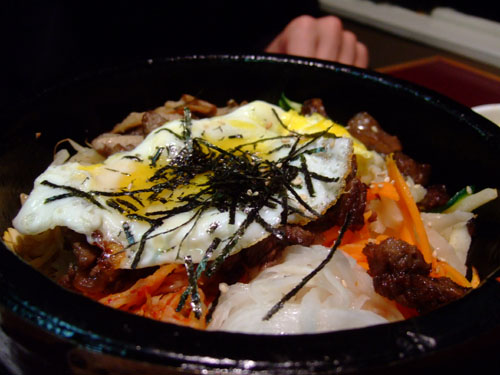
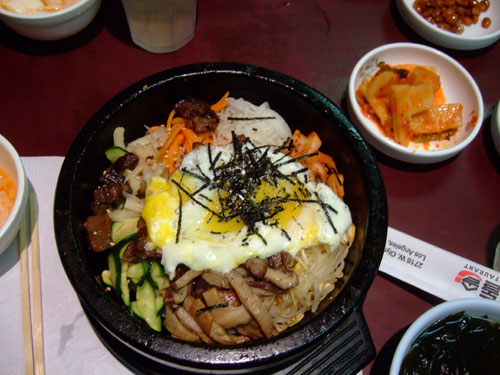
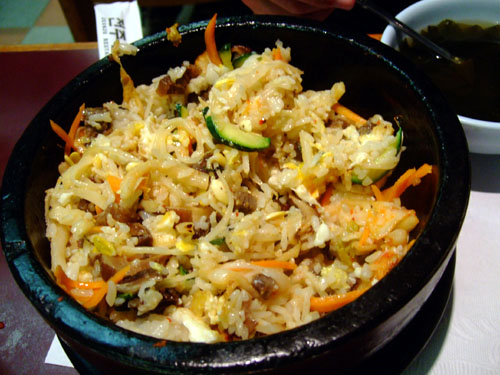
Kalbi Dor Sot Bibim Bap [$10.19]
Kalbi mixed with vegetables over rice. This is Jeon Ju's signature bibimbap. Apparently, its uniqueness is derived from the use of kalbi (marinated beef short ribs) as the meat component; otherwise, it's a pretty typical preparation. Ingredients included kalbi, mu (daikon), kimchi, kongnamul (bean sprouts), mushroom, cucumber, doraji (bellflower root), carrot, egg, gim (seaweed), and sesame. I thought it was delicious, with a harmonious mixture of ingredients and just the right amount of rice; everything simply flowed and melded together into a tasty amalgam. This compared very favorably to the bibimbap I had at Young Dong, though I can't say for certain that one was better than the other.
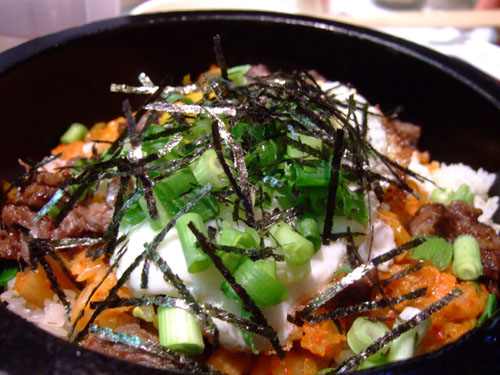
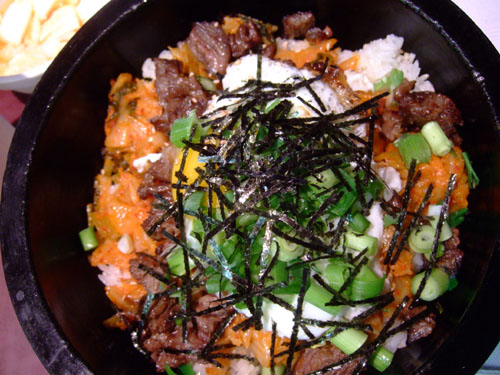
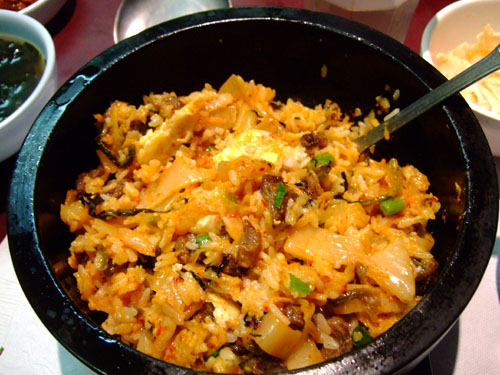
Kimchee Dor Sot Bibim Bap [$10.19]
Cooked kimchee mixed with kalbi over rice. This was my first time having bibimbap with kimchi as the dominant ingredient. In addition to kimchi, the dish included kalbi, egg, scallion, and gim (seaweed). The addition of vast amounts of kimchi to the bibimbap gave the dish a golden color as well as a unique, tangy flavor. Gochujang was actually not needed, as the kimchi provided sufficient spice. I can't say that I prefer this over a normal bibimbap, but it was nevertheless very good, and I would order it again to mix things up.
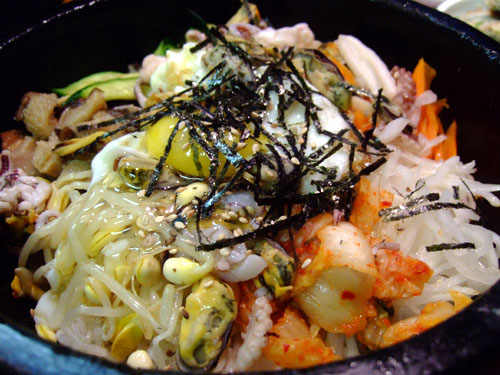
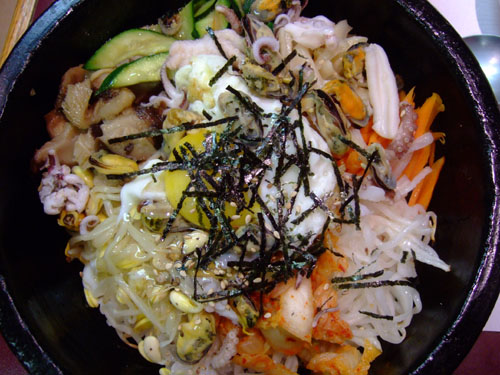
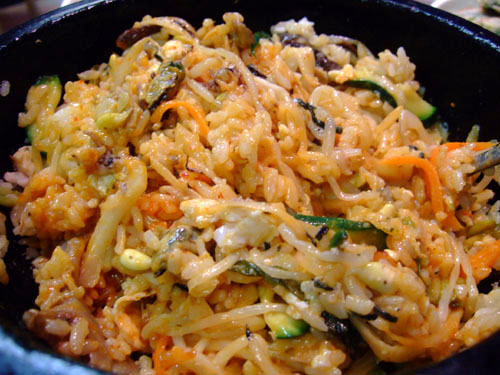
Haemool Dor Sot Bibim Bap [$10.19]
Seafood mixed with vegetables over rice. The ingredients here were kalbi, nakji (octopus), mussels, carrot, mu (daikon), kimchi, kongnamul (bean sprouts), mushroom, cucumber, imitation crab, shrimp, egg, gim (seaweed), and sesame. I'd never had a haemool (seafood) version of bibimbap before. When mixed together, the various individual seafood components didn't stand out on their own; rather, they presented a well integrated, unified flavor front, tied together by plenty of gochujang. A delectable, welcomed addition to my bibimbap repertoire.
For a place that's gotten so much hype for its bibimbap, Jeon Ju did not disappoint. The "standard" bibimbap was amongst the best I've had, and I much appreciated the additional kimchi and haemool varieties. Next time I'm back though, I do want to see if everything else on the menu is just as good!
2716 W Olympic Blvd, Los Angeles, CA 90006
213.386.5678
www.yelp.com/biz/jeon-ju-restaurant-los-angeles (Yelp, restaurant has no web site)
Sat 09/13/2008, 08:35p-09:45p
After having bibimbap for the first time in Japan, I desperately wanted to recreate the experience here in the States. While early attempts left me wanting, I'd since been convinced that comparable bibimbaps were indeed available stateside, but I still hadn't had it in Koreatown. That's where Jeon Ju comes in. The restaurant came highly recommended by a number of people, including a commenter on this very blog. Let's see how it stacked up.

Jeon Ju is located on the first floor of a two-story strip mall. Parking is provided in a small lot, which I hear can become quite packed at peak hours.


The interior is fairly small (though the mirrors make it seem bigger), with seating for about 50 people. There's not much decor to speak of, though the Korean script gracing the walls is somewhat unique.


Jeon Ju can do much more than bibimbap, as evidenced by the fairly lengthy menu. Note however that the three preparations of bibimbap are highlighted right up top. Also note the odd pricing, as I encountered at Young Dong Tofu, presumably to simplify tax calculations. Click for larger versions.
We'll begin with a recounting of the various banchan that we were presented with.

Broccoli with Gochujang
Raw broccoli goes quite well with a cool Ranch dressing. I found out that it also goes well with spicy gochujang, a Korean condiment made with chili powder, glutinous rice powder, fermented soybeans, and salt. Gochujang is also widely used as a flavoring for bibimbap, as we'll see below.

Cheongpomuk Muchim
Cheongpomuk, also known as nokdumuk, is a Korean muk (jelly) made from mung bean starch. The jelly was well garnished with soy sauce and scallion, as the cheongpomuk had little flavor of its own. The consistency was dense, and slightly chewy, reminiscent of Japanese konnyaku jelly.

Ggakdugi
Ggakdugi is a type of kimchi made from mu (daikon radish). The radish is cubed and typically flavored with salt, red chili powder, scallions, and ginger. I much enjoyed the ggakdugi's crispness and milder flavor.

Baechu Kimchi
A meal just wouldn't seem complete without kimchi, specifically baechu kimchi, the most popular variety, made from napa cabbage. This was exactly what I expected from kimchi, and I found it to be spicier and saltier than the ggakdugi and water kimchi below.

Kong Gan
I was informed by one of my dining companions that this was known as "white bean." I'm thinking these are azuki beans perhaps? Unfortunately, I forgot to sample them.

Pajeon
Pajeon is a type of jeon, a pancake-esque dish made of eggs, flour, and green onion. It was soft in texture with a mild flavor, and was one of my favorite banchan.

Mul Kimchi
Mul means water, so this was basically kimchi in water. It had a much milder taste than normal kimchi, with less salt, but still packed a delightfully garlicky tangy. Very nice.

Miyeok Guk
Miyeok guk is a soup made from wakame, a type of edible kelp commonly used in Japanese cookery.
As Jeon Ju is most well known for bibimbap, we decided to try all three varieties offered, all served dolsot style (in a stone pot).



Kalbi Dor Sot Bibim Bap [$10.19]
Kalbi mixed with vegetables over rice. This is Jeon Ju's signature bibimbap. Apparently, its uniqueness is derived from the use of kalbi (marinated beef short ribs) as the meat component; otherwise, it's a pretty typical preparation. Ingredients included kalbi, mu (daikon), kimchi, kongnamul (bean sprouts), mushroom, cucumber, doraji (bellflower root), carrot, egg, gim (seaweed), and sesame. I thought it was delicious, with a harmonious mixture of ingredients and just the right amount of rice; everything simply flowed and melded together into a tasty amalgam. This compared very favorably to the bibimbap I had at Young Dong, though I can't say for certain that one was better than the other.



Kimchee Dor Sot Bibim Bap [$10.19]
Cooked kimchee mixed with kalbi over rice. This was my first time having bibimbap with kimchi as the dominant ingredient. In addition to kimchi, the dish included kalbi, egg, scallion, and gim (seaweed). The addition of vast amounts of kimchi to the bibimbap gave the dish a golden color as well as a unique, tangy flavor. Gochujang was actually not needed, as the kimchi provided sufficient spice. I can't say that I prefer this over a normal bibimbap, but it was nevertheless very good, and I would order it again to mix things up.



Haemool Dor Sot Bibim Bap [$10.19]
Seafood mixed with vegetables over rice. The ingredients here were kalbi, nakji (octopus), mussels, carrot, mu (daikon), kimchi, kongnamul (bean sprouts), mushroom, cucumber, imitation crab, shrimp, egg, gim (seaweed), and sesame. I'd never had a haemool (seafood) version of bibimbap before. When mixed together, the various individual seafood components didn't stand out on their own; rather, they presented a well integrated, unified flavor front, tied together by plenty of gochujang. A delectable, welcomed addition to my bibimbap repertoire.
For a place that's gotten so much hype for its bibimbap, Jeon Ju did not disappoint. The "standard" bibimbap was amongst the best I've had, and I much appreciated the additional kimchi and haemool varieties. Next time I'm back though, I do want to see if everything else on the menu is just as good!
17 Comments:
Yay! Glad you had a chance to try it~ Seems like the prices went up tho! Hmmm..I sometimes get the "Eun dae gu joo rim" =P Let me know if you need any other suggestions for korean food as I am korean =P
What about for sundubu jjigae? I've heard Tofu Village is the best for that (and not bad for BBQ either!).
Thanks for another great post Kevin with wonderful pictures and detailed writing. Also I learned something from your post, that I've been eating bibimap every week. They have it at Tsuruhashi but they call it hot stone pot rice or something of the sort and it's quite delicious, your post is making me hungry.
Lol, I'm glad you learned something from my post. I still need to try Tsuruhashi though; now that I know they have bibimbap I'll need to try that too when I go.
digkv: I tried the bibimbap at Tsuruhashi. It was quite good, though not the best I've had. Next time I need to try the kimchi bokkeumbap!
Oh wow nice to see there is a place with great bibimbap in the States. I use to have it every week in Australia but sadly have not found a good place to do that since.
Looks delicious. Which one is your favourite? I always go back to the classic one
I've been on a bibimbap binge every since having it in Japan. I'd say that the classic one is probably my favorite, though all were very good.
LOL I think we have very similar tastes in food. Tangbro1 was saying you liked your fish firmer too...
hmm soondubu is harder..! i actually don't eat it much anymore. most ppl go to beverly soon tofu, so kong dong (same plaza as jeon ju) and BCD (the one on wilshire is ok and 24 hrs) haha i'm sorry i'm not much help! btw..i did like young dong tofu..but i found a hair in the kimchi..=P hard to totally enjoy my food after that~
Tubs: Yes I prefer it firmer, flaky, and flavorful.
mia: Thanks for the recs! Sucks about the hair though.
For a little background info: Jeon Ju is an area in Korea that is quite famous for its bibimbap specialty; a lot of people swear that they have the best presentation/taste/combination of veggies than in the rest of Korea. Hence explaining the name of the restaurant.
Otherwise... am so terribly jealous that you live in Cali and get this food on a regular basis!
Hayne, thanks for the tip. SoCal is definitely a great place for food like this, where exactly are you?
This is probably a very broad question, but can you give me some advice on the best Korean restaurants in SoCal? Thanks for your help!
Yes, way too broad! Are you talking about KBBQ? Soondubu?
Truthfully, my professor asked what is a good Korean restaurant in SoCal, probably because someone is visiting. Plus, I really know nothing about Korean cuisine, but would be interested in your suggestions myself! Some advice on restaurants that cater to the different segments of Korean cuisine would be great! Thanks
Jeon Ju is sort of the go-to place for bibimbap. Sokongdong and Beverly Soon Tofu are generally considered the top places for soondubu. And for the ubiquitous KBBQ, Park's, Soot Bull Jeep, and Chosun are places that come up often.
You might want to take a look at this Chowhound thread: http://chowhound.chow.com/topics/600475
Thanks Kevin! I may just go check some of these places out myself!
Post a Comment
Subscribe to Post Comments [Atom]
<< Home